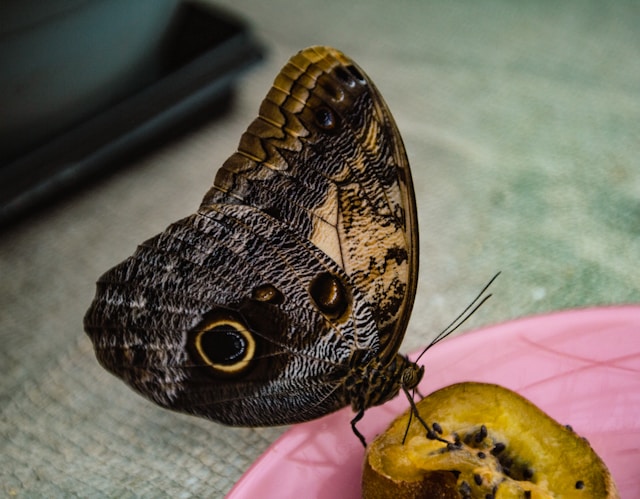Welcome to the enchanting world of Morpho butterflies in Belize, where nature’s palette comes alive with a symphony of colors and patterns. Beyond the famed Blue Morpho, Belize is a sanctuary for several other morpho species, each boasting its own unique and mesmerizing beauty. In this article, we delve into the captivating realm of these winged wonders, exploring their vibrant hues, intricate designs, and the efforts to conserve their natural habitats in Belize’s diverse ecosystems. Join us on a journey through Morpho Magic, where every flutter unveils a new chapter in the story of Belize’s butterfly beauties.
The Blue Majesty: Unraveling the Mystique of Belize’s Iconic Blue Morpho
In the dense rainforests of Belize, a shimmering gem reigns supreme—the Blue Morpho butterfly. Instantly recognizable by its striking iridescent blue wings, this iconic species captivates the imagination of all who encounter it. The secret behind its mesmerizing hue lies not in pigments, but in the intricate structure of its wing scales, which reflect and refract light to create a dazzling display of blues that range from deep azure to brilliant turquoise.
One of the largest butterflies in Belize, the Blue Morpho (Morpho menelaus) boasts a wingspan of up to six inches, making it a majestic sight as it glides gracefully through the forest canopy. Its wings are not only a visual spectacle but also serve a vital purpose in its survival. When at rest, the Blue Morpho closes its wings, revealing a more subdued underside that camouflages it against predators and tree bark, blending seamlessly into its surroundings.
The life cycle of the Blue Morpho is a testament to nature’s marvels. Starting as tiny eggs laid on host plants like passion vines, the larvae hatch into caterpillars that undergo several molts before transforming into pupae. The pupae, or chrysalides, hang from branches or vegetation, undergoing a miraculous metamorphosis before emerging as stunning adults ready to take flight.
Beyond their aesthetic appeal, Blue Morphos play a crucial role in Belize’s ecosystem as pollinators and indicators of environmental health. Their presence in the wild signifies intact habitats and thriving ecosystems, making them valuable subjects of conservation efforts. However, these magnificent butterflies face challenges such as habitat loss and climate change, highlighting the importance of sustainable practices and conservation initiatives to safeguard their future in Belize’s biodiverse landscapes.
In the next sections, we’ll delve deeper into the unique characteristics, behaviors, and conservation status of Belize’s Blue Morpho butterflies, shedding light on their significance in the intricate tapestry of the country’s natural heritage.
Beyond Blue: Discovering the Kaleidoscope of Colors in Belize’s Morpho Species
While the Blue Morpho steals the spotlight with its azure brilliance, Belize is home to a diverse array of Morpho species, each showcasing a kaleidoscope of colors that rival even the most vibrant tropical blooms. From radiant greens to dazzling yellows and iridescent purples, these lesser-known Morphos add depth and richness to Belize’s butterfly population, offering a glimpse into the spectrum of nature’s artistry.
One such species is the Emerald-patched Cattleheart (Parides sesostris), a Morpho with wings adorned in a mesmerizing blend of emerald green and black, punctuated by bold patches of white. This striking coloration serves as a warning to predators, signaling toxicity due to its larval host plant’s toxins, making it a fascinating study in coevolution and natural defense mechanisms.
Moving away from greens, the Yellow-edged Morpho (Morpho rhetenor) dazzles with its sunshine-hued wings accented by intricate black borders and delicate white markings. This species, often found flitting among sunlit clearings and forest edges, adds a cheerful splash of color to Belize’s tropical landscapes, embodying the vibrancy and diversity of the region’s butterfly fauna.
Venturing into deeper shades, the Purple-banded Morpho (Morpho cisseis) enchants with its regal purple wings adorned with intricate bands and patterns that seem to shimmer in the dappled sunlight. This species, known for its elusive nature and preference for forest understories, adds an aura of mystique to Belize’s butterfly tapestry, drawing enthusiasts and researchers alike into its captivating allure.
As we explore these and other Morpho species in Belize, we uncover not just a world of colors but also a testament to nature’s creativity and adaptation. Each species, with its unique hues and patterns, contributes to the ecological richness of Belize’s habitats, underscoring the importance of biodiversity conservation and sustainable practices to preserve these living works of art for generations to come.
Conservation Spotlight: Preserving the Natural Habitat of Morpho Butterflies in Belize
Amidst the lush rainforests and diverse ecosystems of Belize, efforts are underway to protect the precious habitats that sustain the enchanting Morpho butterflies. These conservation endeavors not only safeguard the butterflies themselves but also contribute to preserving the overall biodiversity and ecological balance of the region.
One of the key challenges facing Morpho butterflies in Belize is habitat loss due to deforestation and human activities. As forests shrink and fragmented habitats emerge, butterfly populations face increased pressure, leading to reduced breeding success and genetic diversity. Conservationists, alongside local communities and government agencies, are working to address these threats through habitat restoration, reforestation initiatives, and protected area management.
One notable conservation project is the establishment of butterfly gardens and sanctuaries, where native host plants are cultivated to provide essential food sources and breeding grounds for Morpho butterflies. These sanctuaries not only serve as havens for butterflies but also as educational hubs, raising awareness about the importance of biodiversity conservation and sustainable land use practices among visitors and residents alike.
Furthermore, community-based conservation initiatives empower local stakeholders to become stewards of their natural heritage. By engaging in eco-tourism activities like butterfly watching tours and sustainable harvesting of butterfly-related products such as chrysalides for art and educational purposes, communities generate income while promoting conservation-friendly practices.
In addition to habitat protection, climate change poses a significant threat to Morpho butterflies and their habitats. Rising temperatures, altered precipitation patterns, and extreme weather events can disrupt butterfly life cycles, migration patterns, and food availability. Conservation efforts include climate-resilient habitat design, species monitoring, and collaborative research to understand and mitigate the impacts of climate change on butterfly populations.
Through these concerted conservation actions, Belize aims to secure a thriving future for its Morpho butterflies, ensuring that these winged wonders continue to grace the forests with their beauty and ecological importance for generations to come.
Final Thoughts
The world of Morpho butterflies in Belize is a testament to the wonders of nature, showcasing a symphony of colors, intricate adaptations, and the delicate balance of ecosystems. As we conclude our exploration of these winged beauties, it’s essential to reflect on the significance of conservation efforts and our role in preserving their natural habitats.
The enchanting Blue Morpho and its lesser-known counterparts paint a vivid picture of biodiversity, reminding us of the interconnectedness of all living beings in the web of life. From the vibrant hues of the Emerald-patched Cattleheart to the regal elegance of the Purple-banded Morpho, each species adds to the tapestry of Belize’s butterfly diversity, a treasure trove of natural heritage.
Conservation initiatives play a pivotal role in safeguarding Morpho butterflies and their habitats. Through habitat restoration, protected area management, and community engagement, we can create havens where butterflies thrive and ecosystems flourish. Education and awareness are equally vital, inspiring stewardship and fostering a deeper appreciation for the intricate beauty and ecological importance of these winged wonders.
As we face challenges such as habitat loss, climate change, and human impacts, collaboration and collective action are key. By working together, from conservation organizations to local communities and governments, we can chart a course towards a sustainable future where Morpho butterflies continue to enchant and inspire generations to come. Let us cherish and protect the natural treasures of Belize, ensuring that the flutter of Morpho wings remains a timeless symbol of nature’s resilience, beauty, and wonderment.




